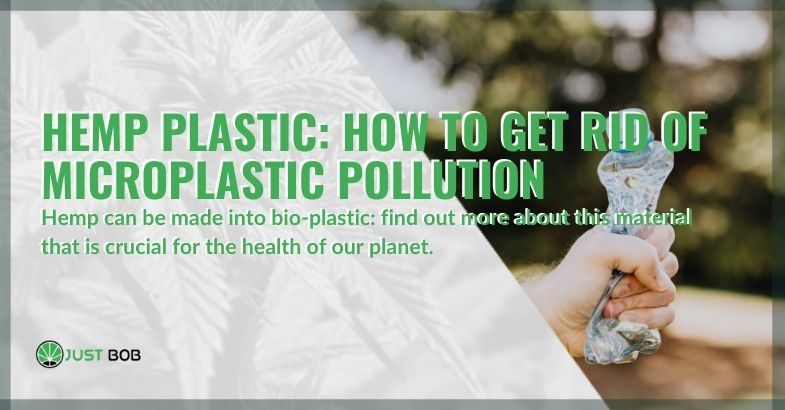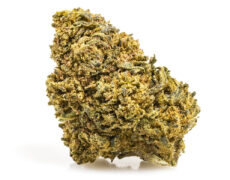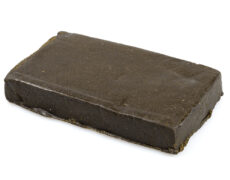Modified on: 23/05/2024
HEMP CAN BE MADE INTO BIO-PLASTIC: FIND OUT MORE ABOUT THIS MATERIAL THAT IS CRUCIAL FOR THE HEALTH OF OUR PLANET
Nowadays, in addition to the many studies carried out on the molecules and substances contained in the hemp and CBD cannabis plants, there has also been more focus on the characteristics of its fibres and in particular on the waste substances from industrial processing.
This is how bioplastics were rediscovered, an ecological material with a thousand resources which, if it receives the attention it deserves, could have a huge impact on solving environmental pollution by micro-plastics.
Although still little known, hemp plastic has become a reality, and it seems to have interesting characteristics, to say the least, that are far better than those of the “traditional” plastic we all know.
But that’s not all, it seems that hemp bioplastic is also more advantageous than the vegetable plastics that have become popular not long ago, both from the price and resistance to heat sources points of view (which makes it safe even in the kitchen).
Incredible, isn’t it?
Here we explain how this product is produced, what its incredible positive characteristics are and how it can affect the health of our planet.
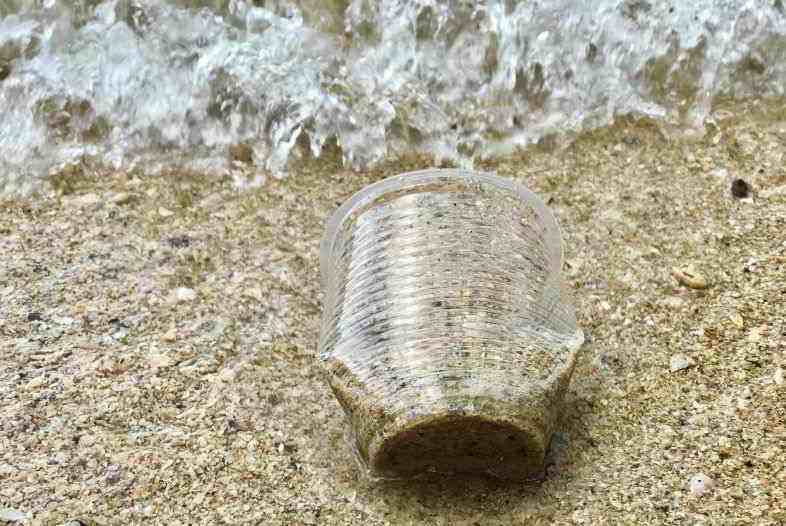

Hemp plastic: how it is produced and when the idea was born
As you can see, nothing is thrown away from cannabis and cannabis light plants.
As well as producing CBD products and other derivatives, it is also possible to take hemp crop produce textiles, to build products and even hemp-based plastics.
But how did this idea come out?
Who thought of hemp plasvtic and how to produce it?
On a national level, a Sicilian company certainly stands out, taking its cue from Harry Ford, who in 1941 built the first prototype car, made almost entirely of plastic hemp.
The young people from Catania in the start-up company Kanesis, with an eye to the future, first looked for an ecological solution for a production of non-polluting plastic materials in industrial waste of vegetable origin and found the answer in cannabis fibres.
This led to the creation of hemp bioplastic, a composite material that is essentially made by processing the plant’s fibres with other biodegradable raw materials (such as corn starch).
The resulting product is decidedly high-performance:
-
it is durable;
-
it is safe;
-
and it doesn’t pollute the planet.
So why didn’t the use of this material take off in 1941?
Despite the incredible discovery, at the time the dissemination and development of this technique was blocked both because of economic issues (oil was booming) and because the hemp plant was demonised and its cultivation was frowned upon.
Fortunately, things have improved since then and it is hoped that from now on, hemp plastic will really spread like wildfire to replace other plastics and petroleum-based plastic.
Read also: Where does cannabis come from?
Hemp plastics: characteristics and areas of use (to get rid of microplastics)
Hemp plastic, made from the hemp fibres out of this plant, is not only environmentally friendly but also has many other positive characteristics.
Here are some of them:
-
it is more resistant than plastic produced from petroleum;
-
it is even 10 times stronger than steel;
-
it resists heat sources;
-
it is very light;
-
it is absolutely non-toxic;
-
it is very elastic.
To make it short, as you can see, this is a product with a thousand properties, decidedly versatile and which can be used to make many objects for the most varied contexts.
But more precisely, what can be made with this material obtained from the waste of marijuana, legal marijuana and legal hash?
The characteristics of hemp bioplastic are particularly suitable for the manufacture of details in the automotive sector, in particular thanks to its strength, elasticity and lightness (it allows less fuel to be consumed as much cellulose does).
In addition to producing rear-view mirrors and other such parts, it seems that hemp plastic can even be used to replace steel sheet metal in cars.
Apart from the automotive sector, producing plastic from hemp can also be useful for making agricultural equipment, everyday objects, electronic components, toys and much more…
Another area in which this material will certainly have a large role to play is in 3D printing, due to its versatility and costs that are half as low as those of better-known bioplastics such as PLA.
In short, the fact that hemp bioplastics being made from hemp can be used in all of these sectors suggests that the idea of a future based on eco-sustainability is increasingly feasible.
Read also: Moon Rock Weed: history and characteristics of this variety
Unveiling the Cost and Advantages of Crafting Plastic from Hemp
In the era of growing environmental consciousness and the pressing need to find sustainable alternatives to traditional plastics, to create hemp plastic is emerging as a promising solution. Hemp plastic, derived from the hemp plant, offers numerous advantages over petroleum-based plastics. This article explores the cost implications of creating hemp plastic, shedding light on the innovative processes and benefits associated with this environmentally friendly material.
The Basics of Hemp Plastic:
1. Hemp Plastics Defined:
Hemp plastic, often referred to as hemp bioplastic, is a type of biodegradable material crafted from the cellulose fibers of the hemp plant (Cannabis sativa). Unlike traditional plastics derived from petroleum, hemp plastics present a renewable resource that has the potential to revolutionize the plastic industry.
2. Hemp Biomass and Cellulose Extraction:
The industrial hemp plant serves as a rich source of biomass, with its cellulose fibers standing out as the key raw material for hemp plastic. The hemp cellulose is extracted from the hemp plant’s cell walls, offering a sustainable and organic polymer for manufacturing.
Cost Factors in Hemp Plastic Production:
1. Growing Hemp:
Hemp cultivation for plastic production involves considerations such as seed costs, field preparation, and harvesting. However, the fast growth cycle of hemp and its minimal need for pesticides make it a cost-effective crop.
2. Manufacturing Process:
The process of creating hemp plastic involves extracting cellulose from hemp fibers. Acid solutions are commonly used to break down the extracted cellulose into nanocrystals, contributing to the formation of the desired plastic compounds. This process is energy-efficient and eco-friendly compared to traditional plastic production methods.
3. Composite Hemp Plastics:
Some hemp plastics are enhanced with composite materials, creating versatile and durable options for applications such as building materials, car panels, and barrier films. While the inclusion of hemp takes these composites may affect costs, the benefits often outweigh the expenses.
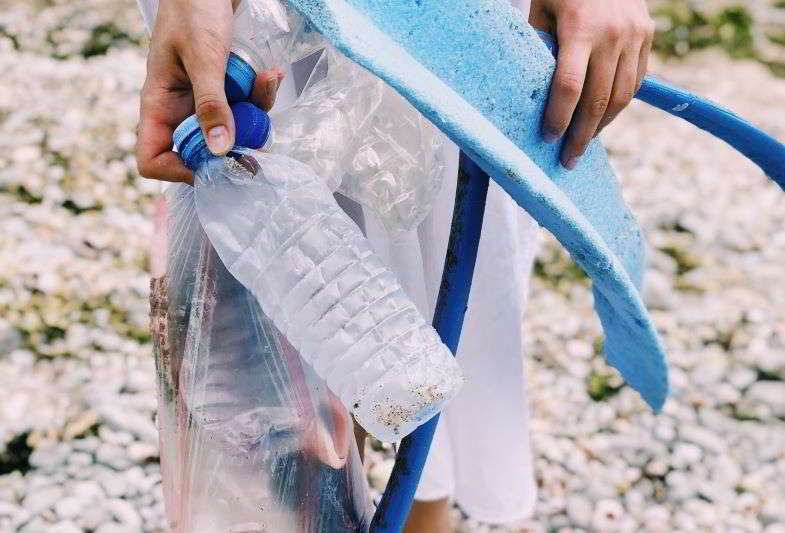

Benefits of Hemp Plastic:
1. Biodegradability:
One of the most significant advantages of hemp plastic is its biodegradability. Unlike traditional plastics that contribute to plastic pollution, hemp plastic decomposes fully, minimizing environmental impact.
2. Carbon Sequestration:
Hemp plants absorb large amounts of carbon dioxide during their growth, acting as a highly absorbent agent for greenhouse gases. This carbon sequestration capability further positions hemp as an environmentally friendly choice in plastic production.
3. Diverse Applications:
Hemp plastics offer a myriad of applications, from everyday items like plastic bags and sanitary products to specialized uses like barrier films and cellophane film. The versatility of hemp plastic makes it a sustainable alternative across various industries.
The Legacy of Hemp Plastic:
1. Henry Ford’s Vision:
Notably, the concept of using hemp products for industrial purposes is not new. In the early 20th century, visionary figures like Henry Ford explored the idea of utilizing hemp materials in car manufacturing, showcasing the enduring potential of hemp in industry.
2. Environmental Impact:
Hemp plastic stands out as a viable solution to address the environmental challenges posed by traditional plastics. With a fully biodegradable nature and the ability to replace petroleum-based synthetic plastics in numerous applications, hemp plastic offers hope for a sustainable future.
Microplastic pollution data and solution in hemp plant
The cost of making plastic from hemp is not just a financial consideration; it encompasses the environmental, social, and economic benefits that hemp plastic brings to the table. As technology advances and consumer awareness grows, the demand for sustainable alternatives like hemp plastic is likely to increase. Embracing hemp plastic production on a global scale has the potential to reduce plastic pollution, combat climate change, and usher in a new era of environmentally conscious material usage.
Today, the environmental impact caused by traditional plastics is truly devastating.
According to a study carried out by WEF (World Economic Forum), it seems that in less than 10 years’ time there will be one ton of plastic in our oceans for every three tons of fish, and that 150 tons of this substance has already been detected.
In various forms, microplastics have already entered the food chain of animals and humans, and the effects on the body do not bode well.
Hemp plastics can be a good solution for limiting global pollution. It does not contain toxic substances such as polylactic acid, PBS and PHA, is biodegradable and does not endanger the fauna of our planet.
In short, bioplastics made from hemp have all the credentials to be preferred to chemical plastics and can make a decisive difference in restoring, at least in part, an increasingly endangered natural environment.
After this insight into the potential of hemp, we now invite you to visit our Justbob store, where you can buy CBD oil, inflorescences and legal hashish to enrich your collection.
We look forward to seeing you in our CBD online shop!

